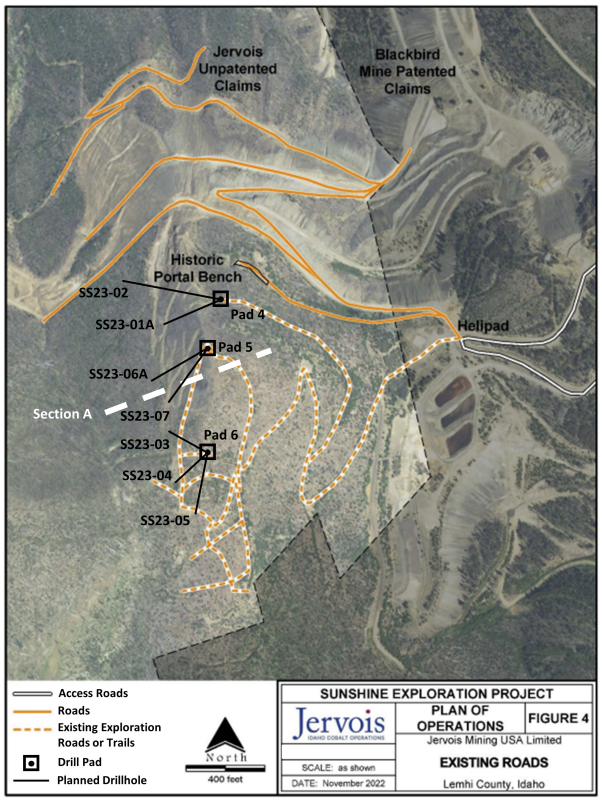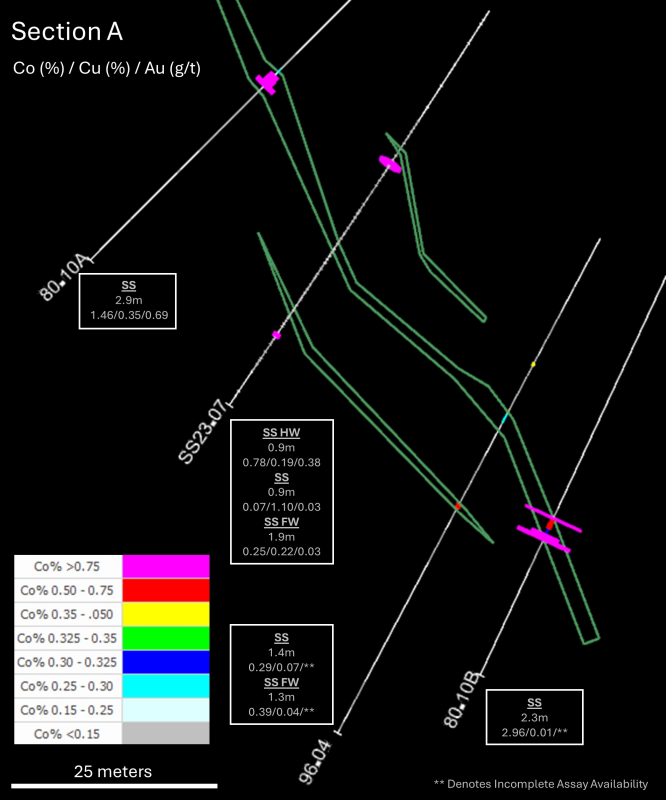Jervois completes U.S. Department of Defense reimbursed drilling at ICO’s Sunshine deposit
(TheNewswire)
Highlights:
-
-
2.9m calculated true width (“CTW”) @ 0.01% cobalt
(“Co”), 0.27% copper (“Cu”), 0.03 grams per metric tonne
(“g/t”) gold (“Au”) (Drillhole SS23-01A)
-
1.2m CTW @ 0.34% Co, 10.05% Cu, 13.68 g/t Au (Drillhole
SS23-02)
-
1.7m CTW @ 0.68% Co, 0.35% Cu, 0.51 g/t Au (Drillhole
SS23-03)
-
0.5m CTW @ 1.55% Co, 0.02% Cu, 1.30 g/t Au (Drillhole
SS23-04)
-
2.6m CTW @ 0.78% Co, 0.12% Cu, 0.41 g/t Au (Drillhole
SS23-05)
-
3.2m CTW @ 0.05% Co, 0.89% Cu, 0.07 g/t Au (Drillhole
SS23-06A)
-
0.9m CTW @ 0.07% Co, 1.10% Cu, 0.03 g/t Au (Drillhole
SS23-07)
-
-
Cobalt has been declared by the U.S. Government a
critical mineral, and a reserve or price floor to sustain domestic
American production has been put forward by the U.S. Congressional
Select Committee on the Chinese Communist Party (see Jervois ASX
announcement dated 13 December 2023, “Jervois welcomes U.S.
Congressional Select Committee proposal for a reserve to sustain
cobalt price”)
30 January 2024 –
TheNewswire
–
Australia – Jervois Global Limited
(“
Jervois
” or the
“
Company
”)
(
ASX:
JRV) (
TSXV:JRV
)
(OTC:JRVMF)
Jervois Global Limited
(“
Jervois
” or the
“
Company
”) (ASX: JRV)
(TSX-V: JRV) (OTC: JRVMF) is pleased to report results from its
inaugural Sunshine drilling campaign at its Idaho Cobalt Operations
(“
ICO
”) in Idaho,
United States (“
U.S.
”).
Collar information is provided in Table 1, along with
tabulated analytical results (Table 2), a plan view map showing drill
pad locations (Figure 1) and a cross-sectional overview of drilling
methodology (Figure 2).
Uncapped drill results include:
-
Hole SS23-01A intersected 2.9m CTW at 0.01% Co, 0.27%
Cu, 0.03 g/t Au.
-
Hole SS23-02 intersected 1.2m CTW at 0.34% Co, 10.05%
Cu, 13.68 g/t Au. In addition, mineralization was encountered in the
hanging wall (
HW
”) to
the Sunshine mineralized horizon, grading 0.42% Co, 0.18% Cu, 0.10 g/t
Au across 1.0m CTW.
-
Hole SS23-03 intersected 1.7m CTW at 0.68% Co, 0.35%
Cu, 0.51 g/t Au.
-
Hole SS23-04 intersected 0.5m CTW at 1.55% Co, 0.02%
Cu, 1.30 g/t Au. Again, additional, mineralization was encountered in
the footwall (
FW
”) to
the Sunshine mineralized horizon, grading 0.15% Co, 0.71% Cu, 0.03 g/t
Au across 2.2m CTW.
-
Hole SS23-05 intersected 2.6m CTW at 0.78% Co, 0.12%
Cu, 0.41 g/t Au.
-
Hole SS23-06A intersected 3.2m CTW at 0.05% Co, 0.89%
Cu, 0.07 g/t Au.
-
Hole SS23-07 intersected 0.9m CTW at 0.07% Co, 1.10%
Cu, 0.03 g/t Au. In addition, mineralization was encountered in the HW
to the Sunshine mineralized horizon, grading 0.78% Co, 0.19% Cu, 0.38
g/t Au across 0.9m CTW, as well as in the FW to the Sunshine
mineralized horizon, grading 0.25% Co, 0.22% Cu, 0.03 g/t Au.
These drilling results will be utilized to confirm
historic drill intercepts, comprised of 19,000m (104 drillholes) of
core drilling, within the Sunshine deposit and be incorporated
alongside within an updated Australian JORC / Canadian CIM compliant
Sunshine Mineral Resource Estimate (“
MRE
”).
ICO continues with the resource extension programme at
its RAM deposit (see ASX announcement dated 20 November 2023,
“Jervois commences U.S. government-funded resource extension
programme at ICO’s RAM deposit”).
Based on the existing U.S. DoD US$15.0 million
Agreement Funding, costs for these exploration programmes, up to the
end of Q3 2024 for exploration development, drilling, logging,
assaying, MRE modelling and Jervois programme supervision, are fully
reimbursed. The Agreement Funding is under the Manufacturing
Capability Expansion and Investment Prioritization office of
Industrial Base Policy using the U.S. DPA Title III authorities and
utilises funds from the Additional Ukraine Supplemental Appropriations
Act.
Table 1: Sunshine Drillhole Collars
|
|
||||||
|
|
|
|
|
|
|
|
|
|
|
|
|
|
|
|
|
|
|
|
|
|
|
|
|
|
|
|
|
|
|
|
|
|
|
|
|
|
|
|
|
|
|
|
|
|
|
|
|
|
|
|
|
|
|
|
|
|
|
|
|
|
|
|
|
|
|
|
|
|
|
|
|
|
|
|
|
|
|
|
*
Coordinates provided in Mine
Grid of RAM Deposit.
**
Drill hole abandoned
prior to mineralized intersection
Table 2: Sunshine Drilling Results
|
|
|
|
|
|
|
|
|
|
|
|
|
|
|
|
|
|
|
|
|
|
|
|
|
|
|
|
|
|
|
|
|
|
|
|
|
|
|
|
|
|
|
|
|
|
|
|
|
|
|
|
|
|
|
|
|
|
|
|
|
|
|
|
|
|
|
|
|
|
|
|
|
|
|
|
|
|
|
|
|
|
|
|
|
|
|
|
|
|
|
|
|
|
|
|
|
|
|
|
|
|
|
|
|
|
|
|
* Sunshine (SS), Sunshine Hangingwall (SS HW), Sunshine
Footwall (SS FW)
** Calculated true widths determined for the composited
intercept mid-point, perpendicular to the down-dip projection of the
Sunshine deposit target models derived from historic Sunshine
drilling
Note:
All grades are reported
uncut for all zones
Figure 1: Sunshine Drill Pad Locations
Figure 2: Sunshine Section A Showing SS23-07 in
Relation to Historic Drill Intercepts
Quality Assurance
Jervois sent all drill core samples to ALS Global
Laboratories (Geochemistry Division), an independent and fully
accredited laboratory (ISO 9001:2008), in Vancouver, Canada, for
analysis for gold by Fire Assay and multi-element Induction Coupled
Plasma Spectroscopy.
Jervois employs a regimented Quality Assurance, Quality
Control (“
QA/QC
”)
program where at least 10% duplicates, blanks and certified reference
material are inserted into each sample shipment.
On behalf of Jervois Global Limited
Bryce Crocker, Chief Executive Officer
For further information, please contact:
Competent Person’s Statement
The information in this release that relates to Mineral
Exploration is based on information compiled by Andrew Turner, P.Geol.
who is a consultant for the company and a member of The Association of
Professional Engineers and Geoscientists of Alberta. Andrew Turner
has sufficient experience which is relevant to the style of
mineralisation and type of deposit under consideration and to the
activity which he is undertaking to qualify as a Competent Person as
defined in the 2012 Edition of the ‘Australasian Code for Reporting
of Exploration Results, Mineral Resources and Ore Reserves’.
Andrew Turner consents to the inclusion in the release of the
matters based on the information in the form and context in which it
appears.
Qualified Person’s Statement
The technical content of this news release has been
reviewed and approved by Andrew Turner, P.Geol., a consultant for the
Company and a Qualified Person as defined by National Instrument
43-101.
Forward-Looking Statements
This news release may contain certain
“Forward-Looking Statements” within the meaning of the United
States Private Securities Litigation Reform Act of 1995 and applicable
Canadian securities laws. When used in this news release, the words
“anticipate”, “believe”, “estimate”, “expect”,
“target, “plan”, “forecast”, “may”, “schedule”,
“expected” and other similar words or expressions identify
forward-looking statements or information. These forward-looking
statements or information may relate to the timing of drilling
operations at ICO, the outcome of the drilling program, timing of an
updated resource model and certain other factors or information. Such
statements represent Jervois’ current views with respect to future
events and are necessarily based upon a number of assumptions and
estimates that, while considered reasonable by Jervois, are inherently
subject to significant business, economic, competitive, political and
social risks, contingencies and uncertainties. Many factors, both
known and unknown, could cause results, performance or achievements to
be materially different from the results, performance or achievements
that are or may be expressed or implied by such forward-looking
statements. Jervois does not intend, and does not assume any
obligation, to update these forward-looking statements or information
to reflect changes in assumptions or changes in circumstances or any
other events affections such statements and information other than as
required by applicable laws, rules and regulations.
Neither TSX Venture Exchange nor its Regulation
Services Provider (as that term is defined in policies of the TSX
Venture Exchange) accepts responsibility for the adequacy or accuracy
of this release.
Appendix 1:
JORC Code, 2012 Edition – Table 1
Section 1 Sampling
Techniques and Data
|
|
|
|
|
|
|
|
|
|
|
|
|
|
|
|
|
|
|
|
|
|
|
|
|
|
|
|
|
|
|
|
|
|
|
|
|
|
|
|
|
|
|
|
|
|
|
|
|
|
|
Section 2 Reporting of
Exploration Results
|
|
|
|
|
|
|
|
|
|
|
|
|
|
|
|
|
|
|
|
|
|
|
|
|
|
|
|
|
|
|
|
|
|
|
|
|
|
|
|
|
|
|
Copyright (c) 2024 TheNewswire – All rights reserved.










